Animal Rescue Stories From Our Volunteers
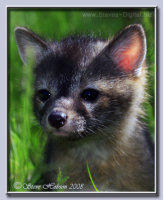
A Sad and Cautionary Tale of a Grey Kit Fox Rescue
This tale concerns the Grey Kit Fox pictured here which was about 4 weeks old at the time of this incident.
The adult humans that found this fox decided it was OK for their 8 year old daughter to play with it. As can be seen in the photo, the fox is very cute and cuddly and thus the normal danger signals were not apparent to the family. Later, the family brought the fox in to the Shasta Wildlife Rescue facility.
Foxes are considered a high risk mammal because they can be a carrier of rabies. SWRR personnel are required to report the animal contact to the Shasta County Public Health Dept., with the additional information that the fox had scratched and licked the child. The priority is for the child’s health and safety.
Unfortunately, the fox had to be destroyed in order for it to be tested for the rabies virus. This healthy, beautiful little fox was put down because the parents didn’t understand the risk they were putting their child in by allowing it to play with the “cute little baby fox”. If the fox tested positive, the child would be subjected to a painful series of vaccinations.
The fox tested negative for rabies. Had the fox not been handled, it could have lived to be set free again in the wild once it was able. Please, please, everyone, if you find an animal, handle it as little as possible and get it to a wildlife rehabilitation center as soon as possible!
Please take a moment to review the information on our Find A Critter? web page for more information on rescuing wildlife and on rabies issues. Our Links web page can refer you to other websites for additional information.
Duckling Rescue
Shasta Wildlife received a call that a mama duck was dangerously leading her babies across the I-5 northbound on ramp off of Cypress Ave. We were told traffic was brought to a halt as cars honked their horns and waited for the duck family to cross.
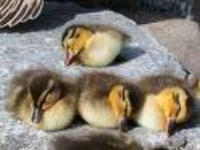
A volunteer rescuer immediately went to the location and tried to find the ducks. We searched the oleanders on the side of the on ramp for quite some time with no luck of finding them.
We were about to give up when animal control arrived. They had received the same report. With the help of the two animal control officers, we finally found the duck family.
We retrieved the 6 baby ducks, which were about a day or two old, but the mother flew away. We waited to see if the mother would come back. We thought if we could catch the mother, we could have relocated the family to a better location and keep them all together. She did not return. SWRR took the babies in, and they were cared for until they were released in a safe location.
Typically mother ducks will find nice nesting spots, hatch their eggs and will begin to walk leading their ducklings, until they find water, which could mean crossing dangerous streets and in this case, a freeway on ramp.

Happy Ending for Baby Killdeer
The day before the 2007 April Baby Bird Shower, my Monday morning crew and I were decorating and doing some last minute clean-up at the Center. While we were doing our thing, someone brought in a baby killdeer only a couple of days old. I asked where they got it from and they said they picked it up there in the park.
They didn’t see any adults around so I picked it up. We went to the spot where they found it and I looked and walked all around and couldn’t see any adult killdeer. So we took care of him while we finished decorating and I was planning on taking him home with me for home care. They get the same set up as the baby quail except they also get live blood worms and I was planning on getting some at a local pet shop in Redding. By the time I left the building, the baby had been away from its family for about 3-4 hours.
Before I left the park, I got my binoculars out and drove really slowly and stopped and scanned the open fields looking for adult killdeer. I did eventually find 2 down the hill from where they found the baby and figured this was Mom and Dad. So I went out into the field and put the baby on the ground. Funny thing is when it was at the center and in the car, it was peeping all the time. When I was walking outside and it could hear the adults, it stopped calling. Then when I put it down, it stayed crouching down instead of running around in a panic like it had been doing the whole time it was in our care. I had to look for it once and thought I’d lost it even though I knew about where I had put it. Then I went to where my car was sitting in the sun (it was over 80 degrees), sat and watched.
Pretty soon it was walking and making its way towards one of the adults and the adult was watching out for it. Eventually the other adult called the OK signal and two more babies that were hiding came out. They were the same age! Then the one with the baby eventually walked it over to the other ones and they all went about the business of feeding and the little one even went under Mom to be warmed up. After sitting out there for an hour sweating my head off, looking through the binoculars, making sure no people came to that area where they were, I left feeling wonderful that I was able to reunite the baby with its family.
Lesson learned: parental instincts are very strong in the animal world if we humans would only give them a chance.
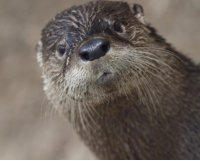
River Otter Pup and Kids
A couple of years ago a distressed father of a young boy called the Center to say that his son and a friend brought home some baby otters. One of the mammal team volunteers went immediately to the home and found out why these two young boys had the pups. Apparently they were playing by a small creek close to home and found a hole under an overturned row boat. Upon investigating the hole, they found the baby otters and took them home with them.
The volunteer asked the boys to take her back to where they found the nest and the boys showed her where it was. Upon arriving, she saw that the top of the “hole” was caved in, apparently from the children stepping on top of it.
The volunteer proceeded to build it back up as well as she could and deposited the babies as far back in the hole as she could reach. After a stern lecture to the children not to touch baby wildlife, they all parted company.
Across the creek was a home where an older gentleman would watch the adult otters coming and going. He stated that he would watch out for them and call her with the news whether or not the adults stayed with the young or abandoned them.
The following morning our volunteer couldn’t wait for the phone call that would give the results of her efforts so early that morning she went very carefully back to the nest to see what happened. It seemed that the parents rebuilt the entrance to the nest and the gentleman across the creek told her that they had been seen going back and forth from the nest so our volunteer deducted that the parents were continuing to care for their babies.
Another happy ending for everyone!
Mama Squirrel Reclaims Babies
One summer the Center received a call from some people that were trimming their trees only to discover that a squirrel nest was in the tree. Too late, the branch was already cut down and in the nest were 5 very young baby squirrels.

A volunteer took the babies home to home care and discovered that one of the babies had a broken leg from the fall. She set the leg and put it in a little cast and proceeded to care for the babies that night.
The following morning, the family that cut the tree down called to say that the mother squirrel was circling the tree where the nest was and the family was hoping that something could be done to reunite the mother with her babies. It is a known fact that mother tree squirrels usually have two nests, one where she raises her babies (the nursery) and an alternate nest in case something happens to the nursery nest or danger occurs at the nursery nest, say for example a predator discovering the babies. If something happens to the nursery nest then she’ll move the babies to the alternate nest.
Knowing that fact, the volunteer brought the babies back to the house, put all five babies at the base of the tree and waited inside the house to see what would happen. Well, mama squirrel showed up and proceeded to take the babies one by one to her alternate nest. She did, however, leave the baby with the bandaged broken leg behind and that one was successfully raised by the volunteer and released back into the wild.
So even though the babies were handled by humans and gone all night from their mother, she still took them back to care for and raise them. Mama squirrel knows best!!!
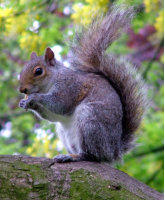
Gray Squirrel Road Rescue
On my way to do a shift at the SWRR center recently, a gray squirrel ran out on the road in front of me on West Anderson Blvd. As I moved to the other lane to avoid hitting the squirrel, I heard a big thug and looked in my rear view mirror. The poor squirrel was on its side and the tail was spinning around. I then turned around on the road as quickly as I could to check it out. Meanwhile, a big truck passed over the squirrel but its tires did not run over it thanks to the driver’s evasive driving action.
The squirrel was still lying on its side as I pulled right up to it.
I shut my engine off while on the road with the squirrel in front of my van as I had no place to pull over. I got my pet carrier out just as a very nice citizen approached behind me and just waited for me. This nice citizen could have easily gone around me while I had the pet carrier next to the squirrel trying to get her.
When I approached the squirrel she was breathing heavily and still lying on her side. I scooted her in the pet carrier and rushed off to SWRR to get her help as I put my thumbs up to the caring citizen behind me. I kept thinking what this poor squirrel went through in a moment’s time.
This squirrel got knocked out by running into a part of my van. Then a semi truck drove over her while she was helpless and choking on a bloody nose while lying on her side. Then some human shoved her into a carrier and stuck her in a van with all kinds of strange noise and sensations. Then after that, a human stuck a gloved hand into the cage to grab her and check her out at the SWRR center. That was when the squirrel decided she had enough and darted out of the cage into our medical room. Marianne got a hold of her and as a sign of appreciation, the squirrel gave Marianne quite a bite right through thick welder’s gloves! At this time it was discovered that she was a nursing mother.
So we released her right away back to her babies, exactly where my van struck her. My heart melted as I watched her run past about 40 trees in a 50 foot stretch of property and right up a particular tree. This squirrel knew exactly what tree she called home! All of this took place in 90 minutes time and involved the kindness of four people independently.
I guess fate saved a mama squirrel and all her babies that day. The babies got their mama back by feeding time and I’m thinking this is a Happily Ever After story!
Bald Eagle Rescue and Release to the Channel Islands
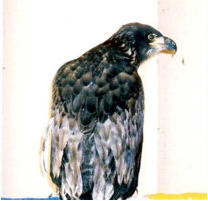

This juvenile Bald Eagle was rehabilitated at our center and then flown by a private plane to the Channel Islands to repopulate the area with Bald Eagles. Six other young ones were flown in from Alaska so this 7th one will bring in a new gene pool.
Red Shoulder Hawk Rescue
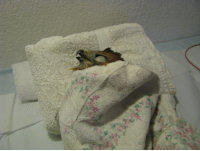


When SWRR received this Red Shoulder Hawk, he looked in very poor shape. He more than likely had eaten from a poisoned food source. He had to be wrapped in a towel and tube-fed by Judy, one of our volunteers. Four days later he had improved greatly as can be seen in the center photo. He was later released by another volunteer, Eloise to join his fellow hawks in the wild.
Rescue of a Nest of Titmice
I had picked up a nest of Titmice at the end of Bowman Road in Cottonwood on the first day of our 2011 season. Yesterday we put them in a cardboard box and I drove them home to be released. On the whole trip back they were dead silent until I got 2 miles from their destination.
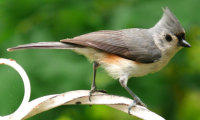
All of a sudden, in chorus, they started to sing the rest of the way. I actually got goose bumps on my arm because somehow I knew that these little souls knew they were going home. I knocked on the door of the people that rescued them in their yard and told them that I was returning the Titmice. We all watched in the front yard as I opened the box. All of them flew up beautifully into a big oak tree. All of us stood in amazement how they were calling each other one or two at a time. IN ENGLISH, they might be saying “ARE YOU THERE?” and return reply “YES, I am here”. The woman of the house gave me a hug.
That was the most awesome experience yet since joining SWRR and becoming a volunteer. 2 weeks ago I looked up Titmouse and learned that they are born and die in the same place. Now I am curious about each and every species of bird that we handle and their natural history.
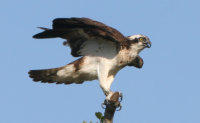
Going Home, Little Osprey
by Marianne D. – The fledgling osprey was found in Elk Creek, by a nest that was up on the telephone pole. I did an exam on him from beak to talons, with Janet S. covering his head to keep his stress level down and Susan M. was kind enough to wipe the dude down with mite spray to get rid of his creepy parasites.
One fun trick that Janet and Susan had never seen before was that I wrapped the ospreys talons with vet wrap then put his feet in little leather “bootie” type pouches, further protection from those big talons! There were no injuries found and the bird seemed in perfect health, except for being a fledgling and being taken rescued when he should have been left alone. The bird was a good eater. It was neat to watch him stand on his fish and eat! We knew it was time for him to go when I went in to check on him and all was fine until I reached down to splash the water his fish was in. He didn’t like that at all and actually flew at me and tried to attack me, which is also what he did the next morning when his food was brought to him. Time for release!
by Janet B. – Today I got the privilege of releasing the Osprey in the Willows area. It was the highlight of my week. As my husband and I were going down the road, he would make some chirping sounds every once in a while, which I liked because then I felt I knew it was okay for the moment. He was stressed but okay. I knew it was cramped and probably a bit warm in the crate. When we got to the location, it was very evident were the nest was that he came from. It was directly overhead. My husband and I pulled over and set up for the release. When I opened the top of the crate he had his head down and seemed to have his shoulders hunched over (it reminded me of my children when they were young – like I’m in trouble now). I then turned the crate on its side so he could walk out. He walked out, turned, looked at me and then looked at the open area. I felt I could see his body language change at that moment saying he was very grateful for his freedom. He took off and flew to a nearby tree, rested a few seconds, then took off again and came around and landed in a tree by the stream. He was resting there when hubby and I left. We went to the reservoir, had a bottle of water and drove back to the nest area. He was up on the nest with either his Mom or Dad. We couldn’t tell which one but we knew they were one of the adults. It was a very moving experience.
Coyote Rescue
by Marianne D. – Above are share photos of the coyote pups I rehabbed from June until their release in November, 2011. In the first photo you will see the pups as they looked when I first got them. They are in my coyote pen behind what they used as their den.
Coyote Rescue
by Marianne D. – Above are share photos of the coyote pups I rehabbed from June until their release in November, 2011. In the first photo you will see the pups as they looked when I first got them. They are in my coyote pen behind what they used as their den.
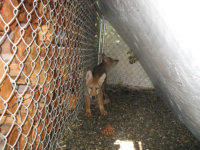
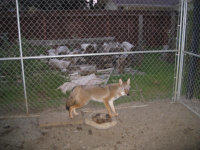
Notice the blackberry branch hanging on the fencing. They actually ate the berries off the vine! The last picture was taken a week or so before release. Speaking of the release, Nicole Carion from the California Department of Fish and Wildlife came to help me crate the coyotes. We thought of videotaping the capturing but decided if it went badly, we would just as soon not have a forever reminder! As a precaution, we did have a vet on site with a tranquillizer dart, ready if needed.
Well, it could not have gone better. There I was, 4 weeks post op with my feet in extra bandages, with my orthopedic special shoes on, garden rake in hand, and Nicole and I had both those coyotes crated and in the back of the transport vehicle in UNDER 8 MINUTES!!!!! From my house, they were driven by a volunteer from the California Department of Fish and Wildlife back up to Siskiyou County and released near where they were found. Their ability to survive now is up to them. I am proud to say that I still only touched one of them one time. I prepared them for release by them having to find their food, which one day was hung 6 feet up on the chain link fencing and the next day having to find it buried in dirt and leaves. They also learned how to hunt maimed (don’t ask) and live feeder food. I followed the weather reports and I feel they were released at exactly the right time.
I want to thank everyone that responded to my pleas for extra food for those 2 big male coyotes. You responded with donations of turkeys, fish, vegetables, and money so I could purchase their favorite aged cube steaks. I want to thank Shasta Wildlife for allowing me to raise and release these coyotes despite the cost. The estimated cost to rehab a single coyote to release age is $4,500. Because of the donations from Shasta Wildlife volunteers and all the road kill deer my daughter butchered, I estimate the cost to raise these 2 pups at approximately $600 for both. To give you an idea of the amount of food they can eat, one night for just the night meal, they were given 50 mice and 8 quail and they ate 50 mice and 6 quail. Remember, that was just the evening meal-at dawn they were given a smaller meal of venison and veggies. Talk about eating machines!
Baby Hummingbird Rescue
Recently SWRR was contacted by a rehabber in Wisconsin who had no experience with Hummingbirds and was asking us for advice. The baby bird was about ready to fledge and was a candidate to be reunited with its own or possibly an adoptive mother.

One of our volunteers experienced in Hummingbird care suggested, “I think the Mom would recognize it’s call if you were able to bring it to the same area where it was found.
She would still be feeding it’s sibling since they always have 2 babies, unless something happened to the other little one. Once they have good flight skills, they will follow Mom to food sources. Whether or not an adopted Mom would tolerate an unidentified youngster following it, especially if she has her own 2 to contend with, I really don’t know. The important thing here is that they have good flight skills.”
We soon received the following report from the rehabber: Today I released the baby, and here is what happened. I went back to the general area where it was found. I had the baby in a “critter keeper”, the plastic see through container with the colored top and a little trap door. I placed it on a table and backed away about 20 feet to the side of the building. Less than 5 minutes had passed when the mother appeared at the chipping of the baby, hovering around the container trying to get at the baby. I opened the trap door and after a few more minutes, the mother appeared again. The baby flew up, out and followed the mother. It happened unbelievably fast! The baby ran out of gas and landed again on the ground. I recovered it and placed it up in a hanging plant. The baby sat in the plant for probably about 5 minutes more or so while the mother foraged below for nectar to feed it. She visited the baby (couldn’t tell if she fed it, too far away) and then flew away. After a bit more flapping the baby flew off and that was the last I saw of it.

Audubon’s Rabbit Rescue
This is one of two Audubon’s Rabbits that was brought to SWRR from Chico. One of our Volunteers successfully raised them and drove to Chico to release them in the Upper Bidwell Park area where the Chico Nature Center said was their habitat. The volunteer was a nervous wreck driving all the way down there.
No talking and no music was allowed to avoid disturbing the animals! They survived the trip and once a good place was found near the creek to release them, they were released in thick cover where they had plenty of room to hide. Live Long & Prosper, little ones!!!
Audubon’s Rabbits aren’t unique; they just aren’t found this far north. Chico is the farthest north of their range. The biologist at Whiskeytown Lake told SWRR we couldn’t release it anywhere farther north than its normal habitat. The last time we had this species, it came from Susanville, where it was returned. A California Department of Fish and Wildlife warden lived there and we made arrangements for her to take it back there and release it.
Baby Jack Rabbit Rescue
A person stumbled on these baby jack rabbits out in the open, one baby still in its birth sac. Fur was scattered around and it wasn’t in a typical nest type of situation. He thinks coyotes got the mom while she was vulnerable during birth. These babies had just been born.
Check back here later for an update on their progress.
A Squirrel Mother’s Day Story
by Jennifer L. – It was the last call of the evening in mid April. The caller found a baby squirrel that had fallen out of the nest in a high palm tree in the next door neighbor’s yard. Its eyes were open and it was fully furred.
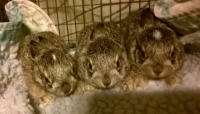

There were two feral cats and a dog on the property, so the caller brought it inside her home and gave it temporary shelter in her cat carrier. She informed me that the little squirrel was active and seemed to be without injury. It was too late in the evening for the little one to be reunited with its mother. Kar, our squirrel expert at SWRR, explained to me that the mom was already home in her nest with her other babies for the night. So I asked the caller to keep the squirrel safe until morning when she could return it near the tree where she had seen the mother and watch to see if the two would find each other. She was agreeable. The next morning, I called back to find out that the squirrel mother and baby had been reunited. Here’s what happened as related to me:
The next morning, the finder heard the mother squirrel chattering very loudly. Knowing that a reunion would be much safer away from cats and dogs, her husband put the cat carrier, with baby squirrel inside, up on top of the roof of the house next door. They left the door to the carrier open, but baby did not come out. Next, the husband carefully placed the baby on the roof. Mother made loud sounds and baby answered her calls with loud baby sounds. Finally, mother and baby were reunited on the rooftop. Mama and baby clung to each other (a squirrel hug, maybe) for a short time. Finally, according to the finder, mama squirrel grasped her baby by the belly and scurried up the tall palm to the safety of their home. We were all glad for the happy ending.
SWRR Rescue Stories in the News
Record Searchlight
Note that the Record Searchlight is now requiring a subscription to view most of their on-line news articles. All of their articles that were listed here in the past are no longer available and the links have been deleted.
Other News
Bald Eagle Flies Free After Rehabilitation at the California Raptor Center – YouTube video
Bald Eagle Rescue: Caltrans News – February, 2008
Bald Eagle Rescue Letter of Appreciation: Caltrans District 2 Newsletter (pdf file, 1.3MB)
The story of Snowshoe the lynx – Bend Bulletin
Also see our News & Articles web page for addtional articles.
PG&E Helps Rescue Barn Owl Trapped in Kite String Between Trees
PGE Brochure (pdf file, 405 kB)
Additional Photos of the Barn Owl Rescue:
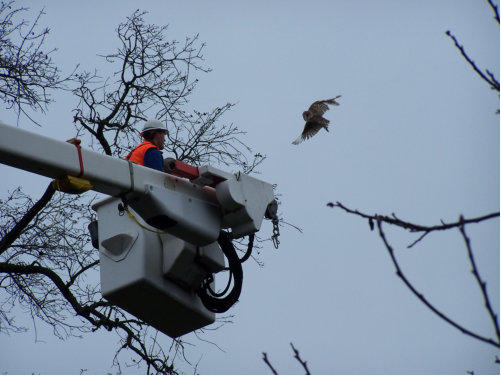
Daryl Chase rides the bucket

The bird is safe

A Barn Owl up close
Write a Rescue Story
We strive to keep the information here current and relevant. We need your help in doing so. We encourage our volunteers to write and submit your own Rescue Story for this page. Contact us at: shastawildlifeinfo@gmail.com



